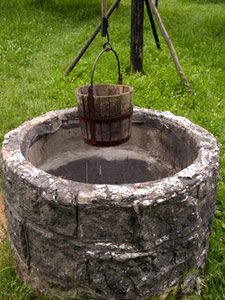| Water Quality Division: Safe Drinking Water: Drinking Water and Your Health |
|
As a result of extensive regulations, guidelines and water quality testing, drinking water supplies in the United State are among the cleanest and safest in the world. Yet the quality of Drinking water comes from two major sources: surface water such as lakes, rivers, and reservoirs; and groundwater, which is pumped from wells. Sometimes these sources are close to a community, but water can also be transported long distances by canals or pipelines. In Arizona, many communities get their drinking water from sources managed by Salt River Project Because of its exposure to the environment and the potential for contamination, surface water typically requires both filtration and disinfection to reach drinking water quality standards. Normally groundwater is considered to be the most pure source of water because it is naturally filtered as it passes through the layers of rock and sediment in an aquifer. However, the geology of the rocks in the aquifer may have a major impact on the quality of the groundwater. Most water systems add chlorine or another disinfectant to ensure the water remains clean within the water distribution system. Disinfection of drinking water supplies was an important advance in public health and a major accomplishment of the 20th century.
Almost all drinking water contains some impurities, whether natural such as minerals or man-made such as chlorine or other disinfectant additives. The U.S. EPA has set standards for more than 80 primary contaminants that may occur in drinking water and pose a risk to human health. These standards, called maximum contaminant levels, are the safety limits established for safe drinking water. The taste and smell of drinking water may also be affected by secondary contaminants, sometimes referred to as aesthetic contaminants. While these contaminants may make tap water less desirable, they do not pose a health risk and are not regulated to the same degree as primary contaminants. ADEQ has adopted maximum contaminant levels that the U.S. EPA established for two different categories of harmful contaminants based on the exposure required to cause health effects. Acute contaminants are those that have health effects that occur within hours or days of exposure. These include microbial contaminants, nitrates and nitrites. Chronic contaminants, by contrast, generally require exposure above the maximum contaminant level for many years to cause harm. The levels for chronic contaminants are based on a lifetime exposure, defined by the U.S. EPA as an average adult consuming 2 liters of water everyday for 70 years. They include many man-made chemicals, some naturally occurring minerals and radionuclides. People with weakened immune systems may be more susceptible to microbial contaminants, including Cryptosporidium, in drinking water. Those in such situations should contact their health care providers to find out if additional precautions are warranted. Young children are particularly susceptible to the effects of high levels of certain contaminants, including nitrate and lead. To minimize the risks of exposure to lead, use water from the cold tap for making baby formula, drinking, and cooking, and let the water run for a minute or more if the water hasn't been turned on for six or more hours. If your water supplier alerts you that your water does not meet the U.S. EPA standard for nitrates and you have children less than six months old, consult your health care provider. You may want to find an alternate source of water that contains lower levels of nitrates for your child until your drinking water system corrects this problem. See Also: |
 water served by individual systems varies over time due to changes in the water source from which it is drawn and the treatment it undergoes.
water served by individual systems varies over time due to changes in the water source from which it is drawn and the treatment it undergoes. Drinking Water Contaminants
Drinking Water Contaminants